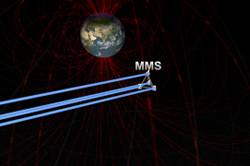The Magnetospheric Multiscale Mission

Project Description:
MMS investigates how the Sun’s and Earth’s magnetic fields connect and disconnect, explosively transferring energy from one to the other in a process that is important at the Sun, other planets, and everywhere in the universe, known as magnetic reconnection. Reconnection limits the performance of fusion reactors and is the final governor of geospace weather that affects modern technological systems such as telecommunications networks, GPS navigation, and electrical power grids. Four identically instrumented spacecraft measure plasmas, fields, and particles in a near-equatorial orbit that will frequently encounter reconnection in action.
Science Goals:
MMS reveals, for the first time, the small-scale three-dimensional structure and dynamics of the elusively thin and fast-moving electron diffusion region. It does this in both of the key reconnection regions near Earth, where the most energetic events originate.
Mission Objective:
- By observing magnetic reconnection in nature, MMS provides access to predictive knowledge of a universal process that is the final governor of space weather, affecting modern technological systems such as communications networks, GPS navigation, and electrical power grids. MMS will establish knowledge, methods and technologies applicable to future space weather missions and the future growth and development of space weather forecasting.
- The four identically instrumented MMS spacecraft fly in an adjustable pyramid-like formation that enables them to observe the three-dimensional structure of magnetic reconnection. This enables them to determine whether reconnection occur in an isolated locale, everywhere within a larger region at once, or traveling across space. MMS sensors will measure charged particle velocities, as well as electric and magnetic fields, with unprecedented (milliseconds) time resolution and accuracy needed to capture the elusively thin and fast-moving electron diffusion region. MMS probes reconnection of solar and terrestrial magnetic fields in the dayside and nightside of Earth’s magnetosphere, the only natural laboratory where it can be directly observed by spacecraft.
